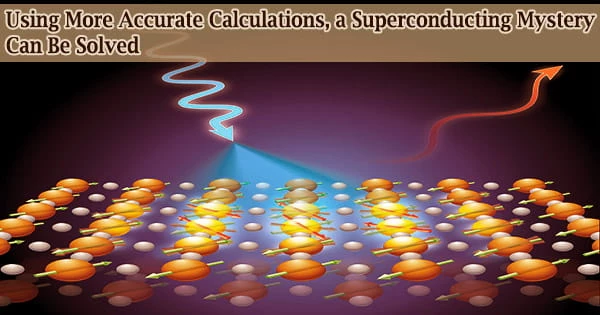Since the 1980s, scientists have been aware of the existence of high-temperature superconducting materials called cuprates. Electrical resistance disappears from these materials below a certain point (about -130 degrees Celsius), and they release magnetic flux fields. However, the causes of that superconductivity are still being discussed and investigated.
“It has been widely accepted that traditional superconductors result from electrons interacting with phonons, where the phonons pair two electrons as an entity and the latter can run in a material without resistance,” said Yao Wang, assistant professor of physics and astronomy at Clemson University.
However, the Coulomb force, which is a strong repelling force between electrons, was discovered in cuprates and was thought to be the reason for this unique and high-temperature superconductivity.
The vibrational energy known as phonons is produced by oscillating atoms inside of crystals. The dynamics and behavior of phonons are considerably different from those of electrons, and it has been difficult to combine these two interacting parts of the puzzle.
In a paper published in the journal Physical Review Letters in November 2021, Wang and colleagues from Stanford University provided strong evidence that phonons are indeed contributing to a crucial property seen in cuprates, which may point to their crucial role in superconductivity.
The study used a novel approach to combine the forces of electrons and phonons. They demonstrated that phonons have an effect on electrons far from their immediate surroundings in addition to those nearby.
“An important discovery in this work is that electron-phonon coupling generates non-local attractive interactions between neighboring electrons in space,” Wang said.
They computed an attractive force that was orders of magnitude weaker than the outcomes of the experiment when they used simply local coupling. This reveals that the longer-range component, which can encompass up to four nearby electrons, is the dominating one.
Wang, the project’s computational lead, simulated experiments performed at the Stanford Synchrotron Radiation Lightsource and reported in Science in September 2021 using the Frontera supercomputer at the Texas Advanced Computing Center (TACC), the fastest academic system in the world and supported by the National Science Foundation (NSF).
If superconductivity comes from Coulomb forces only, we cannot easily manipulate this parameter. But if part of the reason comes from the phonon, then we can do something, for instance, putting the sample on some substrate that will change the electron-phonon interaction. That gives us a direction to design a better superconductor.
Professor Yao Wang
In addition to Frontera’s lightning-fast parallel computing capabilities, the results also drew upon a brand-new mathematical and computational approach that enabled significantly more precision than ever before.
The technique, known as variational non-Gaussian precise diagonalization, may multiply matrices on a vast number of elements.
“It’s a hybrid method,” Wang explained. “It treats the electron and phonon by two different approaches that can adjust with each other. This method performs well and can describe strong coupling with high precision.”
Additionally, an NSF grant helped to fund the method’s development. Even outside of superconductors, the proof of phonon-mediated attraction has profound effects.
“Practically, the results mean we’ve found a way to manipulate Coulomb interactions,” Wang said, referring to the attraction or repulsion of particles or objects because of their electric charge.
“If superconductivity comes from Coulomb forces only, we cannot easily manipulate this parameter,” he said. “But if part of the reason comes from the phonon, then we can do something, for instance, putting the sample on some substrate that will change the electron-phonon interaction. That gives us a direction to design a better superconductor.”
“This research gives new insights into the mystery of cuprate superconductivity that may lead to higher temperature superconducting materials and devices,” said Daryl Hess, a program director in Division of Materials Research at NSF. “They may find their way into future cell phones and quantum computers. A journey started by human creativity, clever algorithms, and Frontera.”
This innovative strategy and the potent TACC supercomputers were also utilized by Wang and University of Alabama at Birmingham colleague Cheng-Chien Chen to examine laser-induced superconductivity.
In November 2021, they published their findings in Physical Review X. And in research that was published in Nature in June 2021, Wang collaborated with a team from Harvard and used TACC supercomputers to explore the development of Wigner crystals.
Supercomputers are the sole tool that can examine the quantum behavior and explain the fundamental phenomena at play, as is the case in many scientific domains.
“In physics, we have very beautiful frameworks to describe an electron or an atom, but when we’re talking about real materials with 1023 atoms, we don’t know how to use these beautiful frameworks,” Wang said.
In particular, physicists have had trouble extending ‘beautiful’ theory to quantum or correlated materials. “So instead, we use ugly theory numerical simulation of the materials. Although we don’t have a well-established quantum computer for now, using classical high performance computers, we can push the problem forward a lot. Ultimately, this will guide experiment.”
To create quantum algorithms that can be tested on both existing and upcoming quantum computers, Wang is now collaborating with IBM and IonQ. “Supercomputing is our first step.”
Wang thinks that computational research, in conjunction with experiment, observation, and theory, will aid in the unraveling of mysteries and the achievement of useful objectives, such as adjustable superconducting materials, when it comes to major future technological advancements.
“A new algorithm can make a difference. More numerical precision can make a difference,” he said. “Sometimes we don’t understand the nature of a phenomenon because we didn’t look closely enough at the details. Only when you push the simulation and zoom in to the nth digit will some important aspect of nature show up.”





